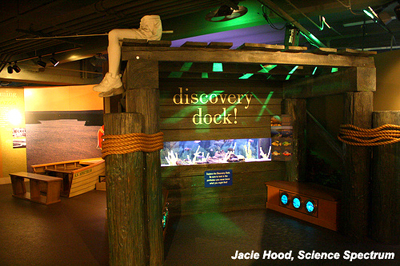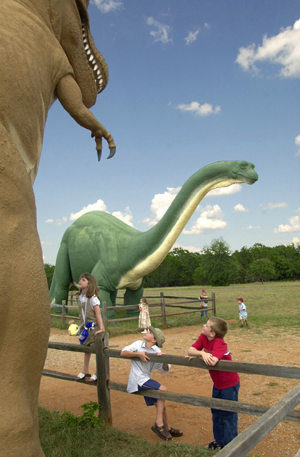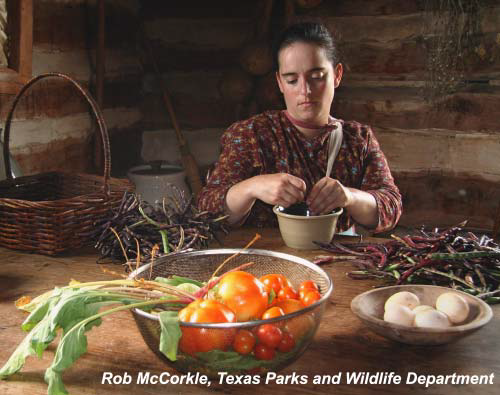The Brazos River basin covers more than 42,000 square miles across the state of Texas. The Brazos and its
tributaries have long provided a home for countless people and animal species. The region’s natural and
cultural history is rich and diverse.
For those interested in learning more about the Brazos, its people, animals and history, opportunities abound.
Wherever you are in the basin, you can likely find a place nearby to expand your knowledge about the Brazos
and have a little fun in the process. Here are some possibilities:

Science Spectrum Museum
You can take a journey down the Brazos and
see examples of its diverse wildlife, without
leaving the Lubbock city limits. “Texas Alive!
The Brazos River Journey,” features more than
30 aquariums and terrariums, featuring
animals you can find in the Brazos basin. The
critters range from rattlesnakes and snapping
turtles to largemouth bass, gar and even
sharks and stingrays.
The permanent exhibit is co-sponsored by
organizations including the Brazos River
Authority, which donated $50,000 to build a
giant model of the water cycle near the
entrance.
“Texas Alive!” is loaded with science and history activities. Hands-on interactive computer exhibits and video
ranger stations let you experience the sights and sounds of the river. You can also catch one of the daily live
animal shows at the Bait Shop Dock.
To learn more about the museum and exhibit, please click here.
Dinosaur Valley State Park
Have you ever walked in dinosaur footprints? You can in the bed of the Paluxy River, a Brazos tributary near
Glen Rose.

About 113 million years ago, the Gulf of Mexico came
up to the area around what is now Glen Rose in
Somervell County. Dinosaurs would travel through the
area in search of food, leaving their footprints deep in
the mud of the tidal flats. Over eons, sediment covered
and protected the prints as the mud hardened to stone.
Today you can find some of the best preserved
dinosaur tracks in the world at Dinosaur
Valley State Park.
The footprints likely are from creatures including the
paluxysaurus, which weighed up to 45 tons and is the
Texas state dinosaur. Other prints are probably by the
acrocanthosaurus, a meat-eating predator, and the
plant-eating iguanodon.
The tracks can be seen in several locations in the
1,523-acre park, which encompasses a scenic bend in
the river. One especially popular viewing site is along a
rock ledge next to the Blue Hole, an old-time swimming
hole.
The park includes 12 miles of hike and bike trails, an
equestrian riding area, a day-use picnic area, group
picnic pavilion with picnic tables and fireplace, and an
outdoor amphitheater. The visitors’ center includes a
store where you can buy souvenirs of your trip.
Dinosaur Valley also offers numerous campsites with electricity, water and nearby restrooms. For the more
adventurous, the park has primitive camp sites that require a 1 to 2 mile hike.
For more information, including fees and hours, call the park at (254) 897-4588 or go to the park’s Web site,
here.
Cameron Park Zoo
Located in Waco’s beautiful Cameron Park, along the banks of the Brazos, this zoo features the “Brazos River
Country” exhibit. Visitors can tour the Brazos in the footsteps of Spanish explorers starting at the river’s mouth
and going upstream.
Entering through a recreated Spanish galleon, one first experiences a 50,000-gallon aquarium that features
fish common to the Gulf Coast.
Moving through the exhibit, visitors travel through simulations of the Brazos’ regions, including the piney
woods, blackland prairie, cross timbers, and the high plains. Along the way one can see many of the animals
common to those regions, from alligators to black bears and otters frolicking in a pond. Jaguars, ocelots,
bison and a colony of bats are among the many critters one might spy.

There are plenty of educational displays
scattered throughout but also numerous places
for the kiddoes to have fun. They can explore
the inside of a teepee or examine a Huaco
Indian hut. Nearby, children can climb a ladder
into a forest ranger’s station to slide down a
clear acrylic tube through the river otter habitat.
To learn more about the exhibit and the rest the
zoo has to offer, please go to this
link.
Waco Mammoth Site
Just up the Brazos, near its confluence with the
Bosque River, is the spot where in 1978 two
men searching for arrowheads and fossils
found a large bone sticking out of a ravine.
Scientists identified the bone as belonging to a
Columbian mammoth, a species of elephant
that has been extinct for thousands of years.
In the years since, workers have excavated 22
mammoth fossils from what is the only
recorded discovery of a nursery herd of
Plestocene mammoths.
Also found in this spot was an extinct camel,
part of a saber-tooth cat and another
unidentified animal. While the cause of the
animals’ death remains a mystery, at least some of them are suspected to have died in a flood.
The site remained closed to the public until 2009, when a public park was opened on the 100-acre property.
The park’s centerpiece is its dig shelter, which allows visitors to view the mammoth fossils from walkways
suspended above, inside a closed, lighted building. The park also features a walking trail and welcome center
with a gift shop.
The site continues to evolve, and officials hope to expand it in the coming years. A bill pending in Congress
would turn the site into the Waco Mammoth National Monument, and would make it part of the National Park
Service.
For more information about the site, call (254) 750-7946 or visit the Web site, here.
Washington-on-the-Brazos State Historic Site
Located in the Brazos River’s lower basin, this site is closely tied to Texas fledgling days of independence
from Mexico. Not only can visitors learn about the state’s early history, they can also get a glimpse of settler
life along the Brazos.

Washington-on-the-Brazos was the center of
several significant events in Texas history. It
was the site of the signing of the Texas
Declaration of Independence in 1836. It was
also the capitol of Texas from 1842 to 1845.
Each year on March 2, Texans from all over
gather at the site to celebrate Texas
Independence Day.
While at the park, one can visit the 10,000-
square-foot Star of Republic Museum. The starshaped
museum contains exhibits,
presentations and displays on the history of the
Texas Republic.
Visitors to the park are encouraged to
participate in the history at the Barrington Living
History Farm. Here one can find the home of
Anson Jones, the last president of the Texas
Republic. Visitors can experience political,
social and economical aspects of the Republic on this working farm. After visiting the historic sites and
working on the farm, visitors can take a break on the beautiful park grounds and relax and picnic along the
Brazos River.
For more information about Washington on the Brazos, please go here.